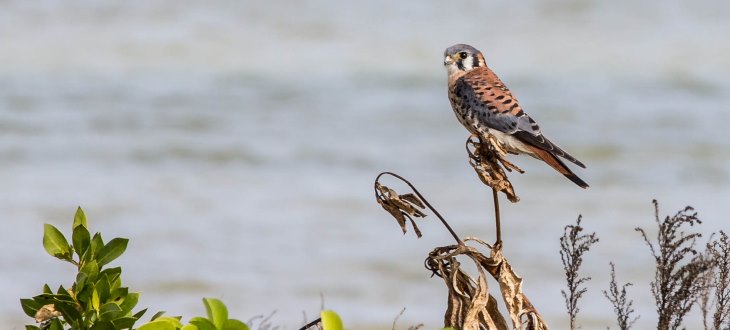The State We're In
A little help for our kestrels
If you build it, they will come.
That’s the hope for new nesting boxes for American kestrels, whose populations have declined severely over the past 50 years.
Kestrels are North America’s smallest and most colorful falcons, and were once common in New Jersey. They were easy to spot perching on trees, fence posts and telephone lines – watching for prey in open fields – and hovering over clearings. But their numbers dropped over 80 percent in the northeast during the past half-century. In New Jersey, they’re now considered threatened and on the brink of endangered status.
The reason for their decline isn’t clear, but experts believe it may be related to the loss of high-quality, large habitats. Other possibilities include fewer nesting places and agricultural pesticides.
“When you look at what New Jersey has become over time, there’s less of the big, open agricultural areas left in the state,” points out Bill Pitts, senior zoologist with the state Endangered and Nongame Species Program who studies kestrels.
Kestrels are about the size of mourning doves, and males have beautiful slate-blue and rust coloring. They’re semi-migratory, with some birds heading south for the winter and others staying in New Jersey.
Kestrels favor open areas with low vegetation and few trees, like meadows, grasslands, pastures and farm fields. They nest in cavities but, unlike woodpeckers, don’t make their own cavities, instead relying on old woodpecker holes, natural tree hollows and rock crevices.
Pitts said “clean” farming practices – like removing hedgerows, trees and brush – may deepen kestrel declines by reducing nesting spots and food sources.
But fortunately, kestrels can adapt to human-altered habitats and will nest in wooden boxes, provided they’re the right size and in the right locations.
The New Jersey Endangered and Nongame Species Program is working with a network of nonprofits and volunteers to place nest boxes in prime foraging habitat where kestrels can hunt for insects, small rodents, snakes, lizards, frogs and small birds.
Here are a few:
- In Burlington County, the Pinelands Preservation Alliance and New Jersey Conservation Foundation are building kestrel boxes this spring and placing them in the 11,380-acre Franklin Parker Preserve in the Pine Barrens, a former cranberry and blueberry farm with a mix of forests and open areas.
- In Mercer County, the Friends of Hopewell Valley Open Space is leading a similar volunteer project this spring to build kestrel boxes and place them on preserved land with suitable habitat.
- In the area where Somerset, Hunterdon and Morris counties come together, Raritan Headwaters Association recently installed about 20 kestrel boxes on public and private land.
In all, said Pitts, New Jersey currently has between 300 and 400 kestrel boxes. Many are monitored by volunteer citizen scientists, who keep track of nesting activity, eggs and chicks. The Endangered and Nongame Species Program bands as many kestrel chicks and adults as they can to better understand their movements and lifespans.
Long-term efforts to help kestrels include about 100 nesting boxes in northwestern New Jersey, maintained and monitored by Dr. John Smallwood of Montclair State University and his students; and more than 80 boxes in Salem and Cumberland counties, maintained and monitored by Steve Eisenhauer of Natural Lands, a nonprofit that preserves land in New Jersey and Pennsylvania. Many of Steve’s kestrel boxes are on preserved farmland, including the Cowtown Rodeo grasslands in Salem County.
The 2,740-acre Duke Farms property in Somerset County hosts and monitors kestrel nests; and another project is led by volunteer Kathy Klink, who monitors kestrel boxes in the Wickecheoke Creek area of western Hunterdon County, with over 4,000 acres of preserved open space and farmland.
Pitts noted encouraging signs of a possible kestrel recovery in New Jersey over the past few years. One sign came last fall, during the annual migrating raptor count in Cape May.
“This past year was the largest flight of kestrels in Cape May since the 1970s – 5,406 kestrels were counted in one day,” he noted. “Hopefully, that means a lot of them come back this spring.”
With luck, when our migrating kestrels return to New Jersey they’ll discover and be enticed by the new nesting boxes.
Want to help? If you own land you think may be suitable habitat for kestrels – or know of preserved public land near you – join volunteer efforts to build and monitor kestrel houses.
To learn more about kestrels, go to https://www.nj.gov/dep/fgw/ensp/pdf/end-thrtened/kestrel.pdf and http://www.conservewildlifenj.org/species/spotlight/kestrel/.
To learn about building nest boxes, go to Cornell Lab of Ornithology’s website at https://nestwatch.org/learn/all-about-birdhouses/birds/american-kestrel/.
And for more information about preserving New Jersey’s land and natural resources, visit the New Jersey Conservation Foundation website at www.njconservation.org or contact me at info@njconservation.org.
About the Authors
Alison Mitchell
Co-Executive Director
John S. Watson, Jr.
Co-Executive Director
Tom Gilbert
Co-Executive Director, 2022-2023
Michele S. Byers
Executive Director, 1999-2021
View their full bios here.
Filter
Get The Latest News
From The Garden State
In the
News

